
Seminars
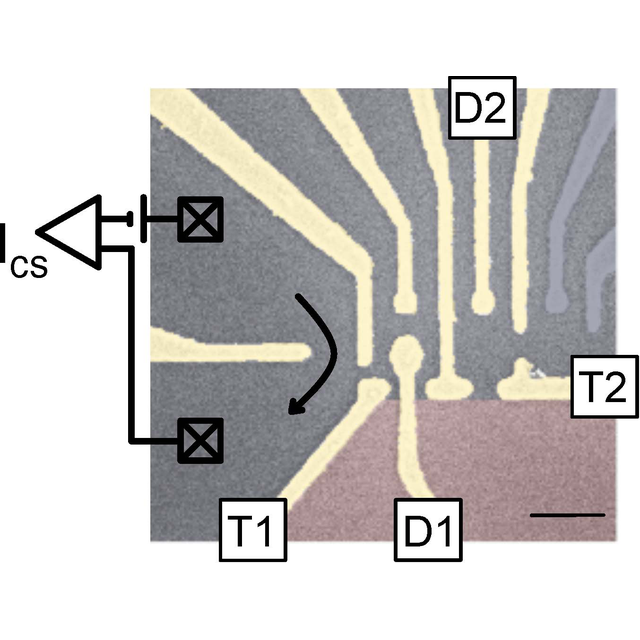
Entropy measurements in mesoscopic quantum systems
C2N - Centre de Nanosciences et de Nanotechnologies, , PalaiseauSeminars
Abstract
Mesoscopic quantum devices offer the experimentalist the ability to implement arbitrary Hamiltonians on a chip, and to measure them with exquisitely sensitive electrical probes. Mesoscopic circuits are used to realize, for example, coupled spin systems with long-lived coherence for qubit applications, or strongly interacting Hamiltonians with frustrated entanglement between a localized state and multiple reservoirs. One reason that experiments based on mesoscopic electronic circuits are so effective is that conductance measurements can be performed with such sensitivity. For example, a conductance measurement of a charge sensor in a mesoscopic quantum circuit can detect charge rearrangements amounting to less than one thousandth of an electron, enabling spin readout on microsecond timescales. This talk will discuss the extension of mesoscopic circuit measurements to the detection of entropy in quantum devices. We start from a proof-of-principle measurement of the entropy change as a single spin is added to a localized quantum state, where the outcome of the measurement (k_B ln(2)) is well known, then move on to interacting systems involving a localized state coupled to other localized states, or to a bath. As an orthogonal metric to ubiquitous conductance measurements, entropy offers a stringent test of our understanding of complex mesoscopic systems.
Keywords
Entropy, quantum electronics, mesoscopic physics, Kondo effect, quantum dots
Joshua Folk has been a professor at the University of British Columbia since 2005. He leads an experimental group building and measuring quantum electronic devices based on semiconductor platforms (typically GaAs 2D electron gases) or van der Waals heterostructures (typically based on graphene). The group’s current research interests centre around thermodynamic probes of quantum circuits, and exploring emergent electronic phases in 2D materials hosting flat electronic bands.
Figure : A prototypical device enabling entropy measurements of a quantum system, in this case consisting of capacitively coupled quantum dots.
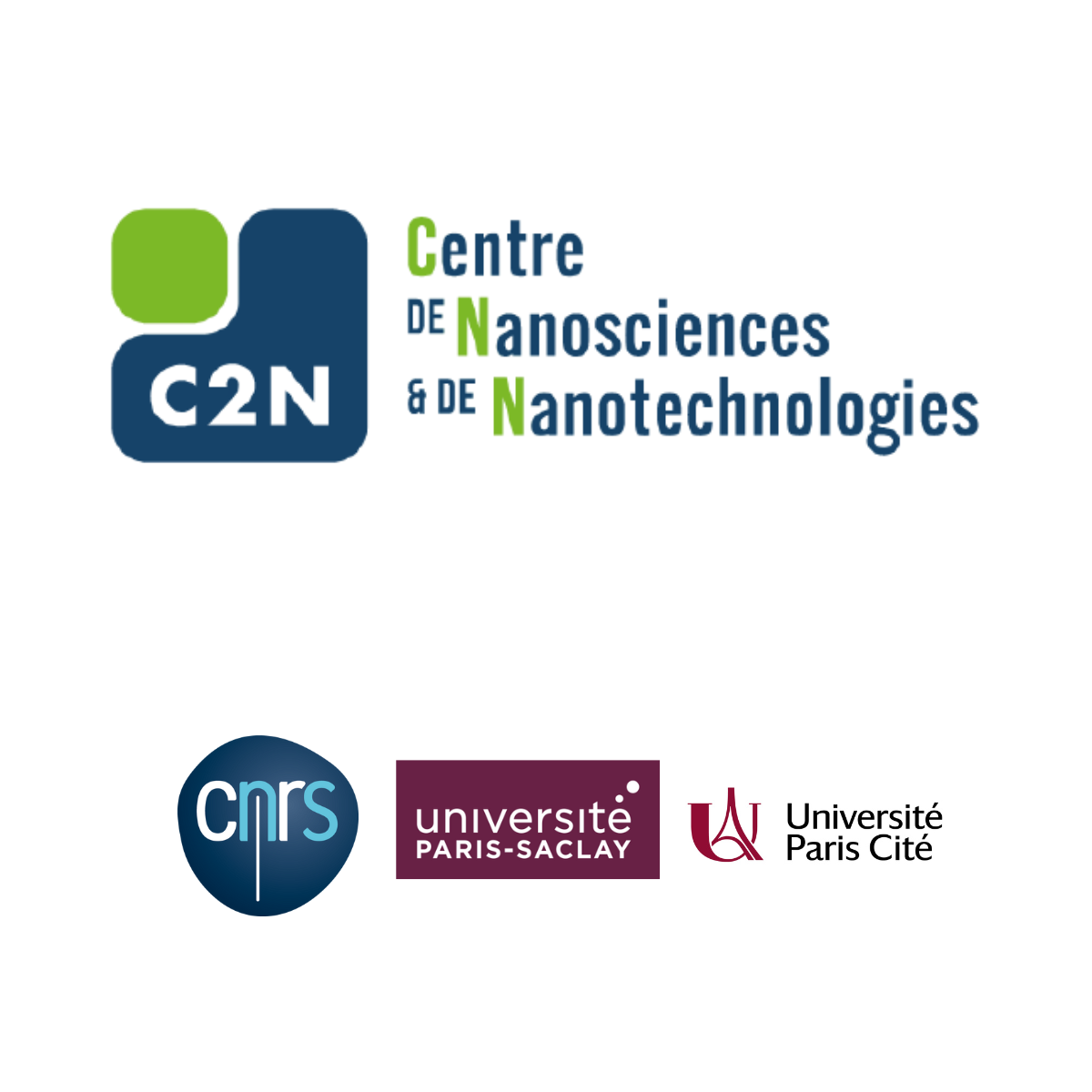
Characterization of complex atomic motion in liquids and glasses: microscopic view of heat capacity and structural relaxation
Centre de Nanosciences et de Nanotechnologies, Amphithéâtre, PalaiseauSeminars
Understanding atomic motion in liquids and glasses is crucial for numerous energy applications from nuclear reactors to batteries. However, unlike crystals, dynamic atomic disorder and lack of periodicity complicate development of microscopic pictures of various thermal and mechanical properties in liquids and glasses. For more than a century, numerous works have, therefore, derived from more established crystal perspectives, of questionable relevance to disordered systems. In this talk, I demonstrate novel, general frameworks to study heat capacity and structural relaxation of liquids and glasses at the atomic scale. Our results show that heat capacity of liquids can be described by a combination of both solid-like and gas-like degrees of freedom, leading to a unified framework to describe heat capacity of all three phases of matter: solid, liquid, and gas. In addition, our work indicates that rather than a specific set of atoms including rattling and string-motion atoms discussed widely in the literature, more subtle and random sets of atoms are responsible for mechanical loss in glasses. These results pave the way towards more universal approaches to understanding complex atomic motion in liquids and glasses.
*This work was supported by the U.S. Department of Energy (DOE), Office of Science, Office of Basic Energy Sciences, Materials and Science and Engineering Division.
Biography: Dr. Jaeyun Moon is a postdoctoral researcher at the Materials Science and Technology Division at Oak Ridge National Laboratory. He received B.S. in Mechanical Engineering from Georgia Institute of Technology and M.S. and Ph.D. in Mechanical Engineering from California Institute of Technology. During his Ph.D., he was a visiting scientist at Stanford University and SLAC National Laboratory. He received a Samsung Fellowship, Resnick Graduate Fellowship, and an Acosta Fellowship. In 2019, Dr. Moon received the International Union of Crystallography Young Scientist Award for his work in thermal properties of glasses.

C2N PhD student seminar
Centre de Nanosciences et de Nanotechnologies, Amphithéâtre, PalaiseauSeminars
- Asma Mouhoub (C2N Nanoelectronics Department) - Magnetic and structural properties of thin and thick synthetic antiferromagnets
- Thi Hao Nhi Nguyen (C2N Photonics Department) - Room temperature integrated photodetector between 5 μm and 8 μm wavelength
- Chen Wei (C2N Material Department)- In-Situ TEM Observation of GaAs Nanowire Nucleation on Si
- Francisco Ambia (C2N Microsystems and Nanobiofluidics Department) - A novel Silicon on Glass electrostatic MEMS for energy harvesting in leadless pacemakers

Magnonics in collinear and canted antiferromagnets: From Spin-Pumping to Magnon-Photon Coupling
Centre de Nanosciences et de Nanotechnologies, Amphithéâtre, PalaiseauSeminars
Recent years have been the frame of a renewal of activity of magnonic and spintronic research on antiferromagnetic materials due to some of their intrinsic and potentially advantageous properties . Their vanishing stray fields, higher resonance frequencies, and the possibility to control them by spin currents renders them scalable, fast and tunable for future ICT devices. However, the implementation of magnonic AFM devices requires a profound understanding of the spin dynamics of AFMs and of their ability to couple to other systems to be integrable with other platforms. Despite huge progress, the capacity to generate coherent and sizeable electrical signal from their magnetization dynamics, and to couple efficiently with photonic excitation in cavities remain mainly elusive.
In my presentation, I will first report on our latest results on the investigation of inverse spin Hall effects generated by AFM resonances using hematite Fe2O3 and chromium oxide Cr2O3 as model systems . I will in parallel discuss on their dynamics can strongly couple with cavity photon and form AFM cavity magnon polaritons. I will evidence that the presence of DMI in the canted phase of Hematite leads to an enhanced spin pumping signal as well as an increase of the magnon-cavity photon coupling strength compared to the collinear phase, achieving cooperativities C>70 for the canted phase. These results pave the way to integrate canted AFMs in future AFM magnonic devices and for information processing with cavity magnonics.
Isabella Boventer a, H.T. Simensenb, B.Brekkeb, M.Weidesc, A. Ananea, M.Kläuib,d,e, A. Braatasb and R. Lebruna
a Unité Mixte de Physique CNRS/Thales, Université Paris Saclay, Palaiseau 91767 France
b Center for Quantum Spintronics, Department of Physics, Norwegian University of Science and Technology, Trondheim Norway
c James Watt School of Engineering, Electronics & Nanoscale Engineering Division, University of Glasgow, Glasgow G12 8QQ, United Kingdom
dInstitut für Physik, Johannes-Gutenberg Universität Mainz, D-55099, Mainz, Germany
eGraduate School of Excellence Materials Science in Mainz (Mainz), Staudinger Weg 9, D-55128 Mainz, Germany
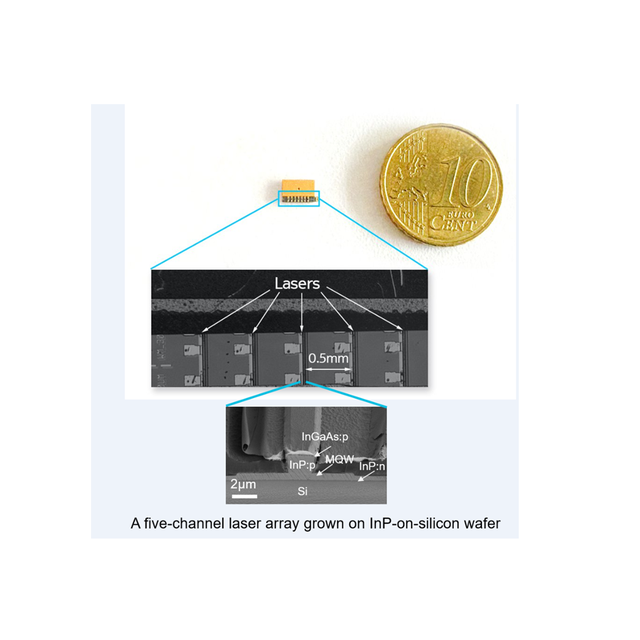
III-V integration onto silicon by bonding and regrowth for high-speed telecommunications
Centre de Nanosciences et de Nanotechnologies, Amphithéâtre, PalaiseauSeminars
The explosive data traffic growth urges telecommunication networks to enhance data rate with
lower price and low power consumption. The integration of III-V semiconductors on silicon (Si) is
being developed for more than 30 years since the potential is huge to combine the III-V’s emitting
properties with the production volume, consumption and optical passive functions offered by the
Si platform.
However, this integration is challenging because of physical incompatibilities between III-V and Si materials such as lattice mismatch, thermal mismatch and differences of polarity. The heterogeneous integration scheme by bonding remains the most suitable option overpass these nearly insurmountable obstacles for III-V direct growth on Si (heteroepitaxy). More recently, a novel integration scheme by bonding a thin film made of Indium Phosphide (InP) followed by III-V epitaxial regrowth has emerged in order to overpass the current integration schemes’ limitations. By suppressing the lattice mismatch and polarity issues between III-V and Si, it allows to combine
the multi-regrowth know-how developed in the III-V on InP historical platform with the advanced Si photonics platform. During my talk, I will explain how this III-V on Si integration scheme has permitted to overpass the historical integration schemes’ limitations allowing to obtain major demonstrations and offering lots of perspectives. In the end, the audience itself will be able to judge if this multi-decadal search for a “perfect” integration scheme between the III-V group and the IV group has ultimately been successful...
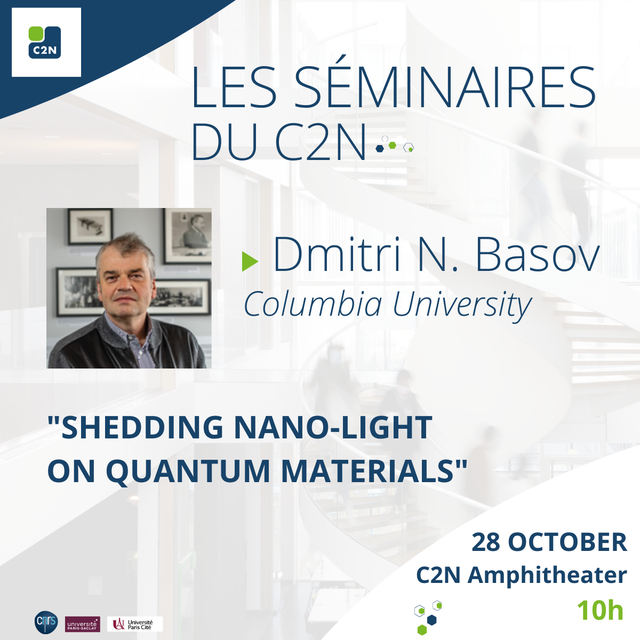
Shedding nano-light on quantum materials
Centre de Nanosciences et de Nanotechnologies, Amphithéâtre, PalaiseauSeminars
Dmitri N. Basov (PhD 1991) is a Higgins professor and Chair of the Department of Physics at Columbia University [http://infrared.cni.columbia.edu], the Director of the DOE Energy Frontiers Research Center on Programmable Quantum Materials and co-director of Max Planck Society – New York Center for Nonequilibrium Quantum Phenomena. He has served as a professor (1997-2016) and Chair (2010-2015) of Physics, University of California San Diego. Research interests include: physics of quantum materials, superconductivity, two-dimensional materials, infrared nano-optics. Prizes and recognitions: Sloan Fellowship (1999), Genzel Prize (2014), Humboldt research award (2009), Frank Isakson Prize, American Physical Society (2012), Moore Investigator (2014, 2020), K.J. Button Prize (2019), Vannevar Bush Faculty Fellowship (U.S. Department of Defense, 2019), National Academy of Sciences (2020).
In this talk, he will describe two recent experiments harnessing nano-scale polaritonic waves (“nano-light”) for probing excitonic effects in van der Waals semiconductors [1] and unconventional electronic properties in the nodal metal ZrSiSe [2].
[1] A. J. Sternbach, S. H. Chae, S. Latini, A. A. Rikhter, Y. Shao, B. Li, D. Rhodes, B. Kim, P. J. Schuck, X. Xu, X.-Y. Zhu, R. D. Averitt, J. Hone, M. M. Fogler, A. Rubio, and D. N. Basov, “Programmable hyperbolic polaritons in van der Waals semiconductors,” Science 371, 617 (2021).
[2] Yinming Shao, Aaron J. Sternbach, Brian S. Y. Kim, Andrey A. Rikhter, Xinyi Xu, Umberto De Giovannini, Ran Jing, Sang Hoon Chae, Zhiyuan Sun, Seng Huat Lee, Yanglin Zhu, Zhiqiang Mao, J. Hone, Raquel Queiroz, A. J. Millis, P. James Schuck, A. Rubio, M. M. Fogler, D. N. Basov “Infrared Plasmons Propagate through a Hyperbolic Nodal Metal” (Science Advances 2022).

Electron-phonon and exciton-phonon interactions in low dimensional carbon systems
Centre de Nanosciences et de Nanotechnologies, Amphithéâtre, PalaiseauSeminars
Carbon, apart from providing the basis for life on Earth, nowadays plays a critical role in many aspects of technological development, (i.e. drug delivery, solar cells, optoelectronics, nano-electronics, etc.). Moreover, thanks to its valency and the possibility of forming hybrid orbitals, carbon can give rise to many allotropes. In this talk I would like to show how apparently simple systems such as carbon allotropes can host strongly correlated phases of matters, such as charge-density-waves (CDW) and topological insulating phase transitions, and how they can affect their optical properties. As a matter of fact the light mass of carbon atoms and low dimensionality enhance the relevance of the many-body nature of electron-electron, electron-phonon and exciton-phonon interactions, as well as a strong anharmonicity of lattice vibrations. In order to do so I will talk about some recent works on linear [1] and cyclic [2] carbon chains as well as topologically insulating poly-acene polymers [3].
[1] "Dominant Role of Quantum Anharmonicity in the Stability and Optical Properties of Infinite Linear Acetylenic Carbon Chains", D. Romanin, L. Monacelli, R. Bianco, I. Errea, F. Mauri and M. Calandra, The Journal of Physical Chemistry Letters 12 (42), 10339-10345 (2021)
[2] "Giant quantum anharmonic effects on the stability, vibrational and optical properties of cyclo[4n+ 2]carbon.", D. Romanin and M. Calandra, Carbon Trends 9 , 100207 (2022)
[3] "Highly tunable optics across a topological transition in organic polymers", D. Romanin, M. Calandra and A. W. Chin, arXiv preprint arXiv:2204.00321 (2022)
Davide Romanin has obtained a B.Sc. in Physical Engineering (2015) and a M.Sc. in Physics of Complex Systems (2017) from Politecnico di Torino (Turin; Italy), together with an M2 in Physics of Complex Systems (2017) from Sorbonne University (Paris, France). After that he decided to specialize in the ab-initio investigation of materials properties: he then obtained a PhD cum laude in Physics from Politecnico di Torino (2021) under the supervision of Prof. Dario Daghero (Politecnico di Torino, Italy) and Prof. Matteo Calandra (Trento University, Italy), where he focused on electron-phonon interactions with a particular interest in conventional superconductivity, charge-density waves and the anharmonic picture of lattice vibration. After that he started a Post-Doc in Dr. Alex W. Chin group, at the Institut de Nanosciences de Paris (Paris, France), where he studied Excitonic properties of organic polymers and carbon molecules and the effects of lattice vibration on the optical absorption. He has been recently recruited as Maître de conférences at Paris-Saclay University and he continues his research in the Computational Electronics group at C2N, where he intends to study the effects of low-dimensionality and topological phase transitions on Excitonic and thermoelectric properties of materials.
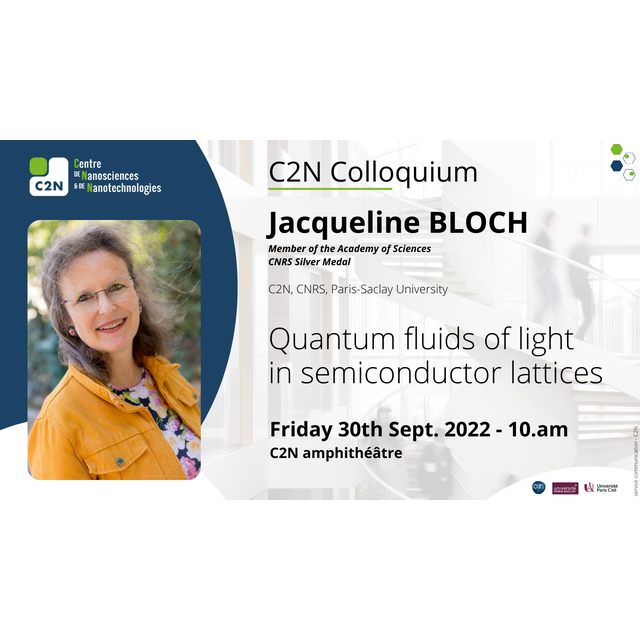
First C2N Colloquium : Quantum fluids of light in semiconductor lattices
C2N - Centre de Nanosciences et de Nanotechnologies, , PalaiseauSeminars
Abstract
When confining photons in semiconductor lattices, it is possible to deeply modify their physical properties. Photons can behave as finite or even infinite mass particles, photons can propagate along edge states without back scattering, photons can become superfluid, photons can behave as interacting particles. These are just a few examples of properties that can be imprinted into fluids of light in semiconductor lattices. Such manipulation of light present not only potential for applications in photonics, but also great promise for fundamental studies. One can invent artificial media with exotic physical properties at the single particle level or even more interestingly when interactions are considered.
During the talk, I will illustrate the variety of physical systems we can emulate with fluids of light by presenting a few recent experiments. Perspectives in terms of analog simulation of complex problems will be discussed.
Biography
Jacqueline Bloch is an experimental physicist, expert in non-linear and quantum optics in semiconductors. After a PhD on semiconductor quantum wires, she started a research program at CNRS on semiconductor microcavities. She has always been convinced that the physics of quantum fluids of light is particularly rich, in particular when taking full advantage of the technological tools available at the Center for Nanoscience and Nanotechnology. Along her carrier, she has explored a variety of physical phenomena, like superfluidity, solitons, flat bands, topology, phase transitions or analog black holes.
Jacqueline Bloch is today Research Director at CNRS, Professeure Chargée de Cours at Ecole Polytechnique and member of the French Academy of Science. She was awarded the 2015 Jean Ricard prize of the French Physical Society, the 2017 CNRS Silver Medal and the 2019 Ampère prize.
Keywords : microcavities, light matter interaction, polaritons, analog simulation, condensates
Registration : inscriptions.colloquia@c2n.upsaclay.fr

International Research laboratory ELyTMaX Engineering Science Lyon Tohoku, Materials and systems under extreme conditions
Centre de Nanosciences et de Nanotechnologies, Amphithéâtre, PalaiseauSeminars
International Research laboratory ELyTMaX
Engineering Science Lyon Tohoku, Materials and systems under extreme conditions
This presentation aims at showing the research activities held at ELyTMaX, and the collaboration possibilities with permanent researchers of Tohoku University in Japan.
ELyTMaX is an International Joint Unit (UMI) launched by CNRS, Université de Lyon (France) and Tohoku University (Japan). The Japan site of ELyTMaX is located at Tohoku University in Sendai, and regroups around 20 people (both from France and Japan) including Full Professors, Associate and Assistant Professors, postdoctoral fellows, double degree PhD, Master students and administrative staff.
ELyTMaX laboratory is conducting research in the engineering science research field, combining expertise from mechanical engineering, electrical engineering, material science and electrochemistry. As an international joint unit, joint expertise of Japanese and French researchers is gathered to investigate together material behavior, and to propose innovative solutions to monitor their lifetime.
The research conducted at ELyTMaX laboratory is both fundamental and applied research, and focuses on the behavior of materials (and the systems they form) under extreme and complex conditions (pressure, temperature, electromagnetic field, radiation, or highly corrosive environments).
In the view of predicting and extending lifetime of materials and structures, three main strategies are developed:
• Fabrication / Repair of the materials and systems, for minimizing or recovering from their degradation,
• Investigation of the behavior of materials, when subjected to complex solicitations or environments, including both structural materials and smart materials,
• Monitoring of the structural health of materials and systems, through Non Destructive Techniques.
These three main strategies are supported by multi-physics and multi-scale modeling, for better understanding physical-chemical insights of materials and systems behavior.
The typical application field is the energy industry (e.g. electrical power plants), transportation and medical devices. The strategy is refined notably through scientific questionings coming from the applications, where the type of degradation of materials which are studied comes from practical cases.
https://www.elyt-lab.com/en/content/elytmax-umi-3757
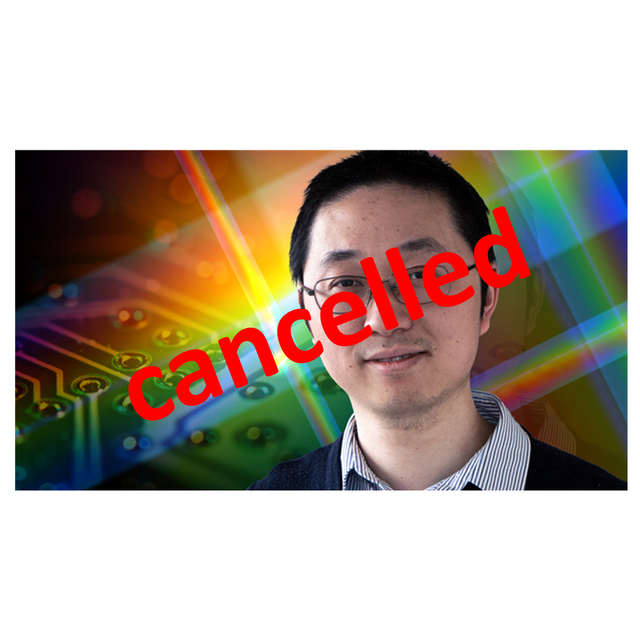
Molding the flow of light with new materials and devices
Centre de Nanosciences et de Nanotechnologies, Amphithéâtre, PalaiseauSeminars
This talk will provide a broad overview of ongoing research in my group and specifically focus on two topics: phase change material (PCM) enabled reconfigurable photonics, and free-form micro-optical couplers for photonic packaging. On the first topic, we leverage the giant optical refractive index modulation (exceeding unity) concurrent with solid-state phase transition in PCMs to create a cohort of tunable photonic structures, including ultra-compact and electrically driven nonvolatile phase shifters, transient photonic structures that can
be made ‘invisible’ on-demand, and zoom lenses with no moving parts. On the latter topic, we discuss an universal optical interface that can be adapted to chip-to-fiber, chip-to-chip and chip-to-free-space coupling with remarkable low insertion loss (0.5 dB) and large bandwidth (> 300 nm) performance.
Juejun (JJ) Hu is currently the John F. Elliott Professor of Materials Science and Engineering at MIT. He holds a Ph.D. degree (2009) from MIT and a B.S. degree (2004) from Tsinghua University, China, both in Materials Science and Engineering. Prior to joining MIT, Hu was an Assistant Professor at the University of Delaware from 2010 to 2014. Hu’s primary research interest covers new optical materials exemplified by chalcogenide compounds, as well as enhanced photonmatter interactions in nanophotonic structures. He has authored and coauthored over 150 refereed journal publications and technologies developed in his lab have led to several spin-off companies. Hu has been recognized with the SPIE Early Career Achievement Award, the Robert L. Coble Award from the American Ceramic Society, the Vittorio Gottardi Prize from the International Commission on Glass, the DARPA Young Faculty Award, and the NSF CAREER Award, among others. He is a fellow of Optica (formerly OSA) and the American Ceramic Society.